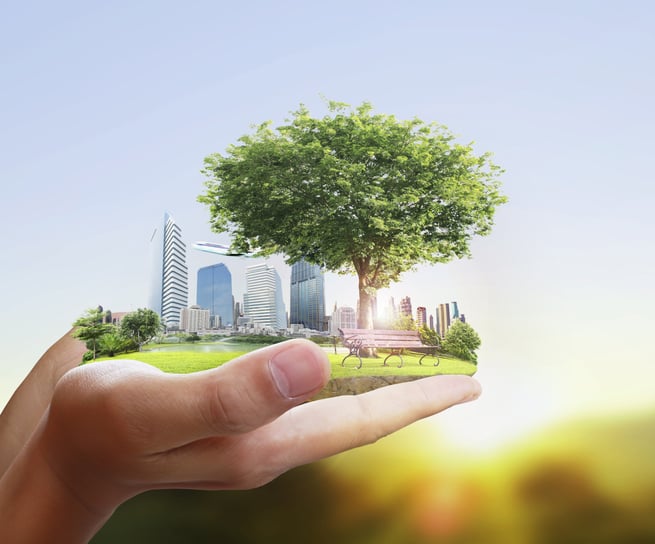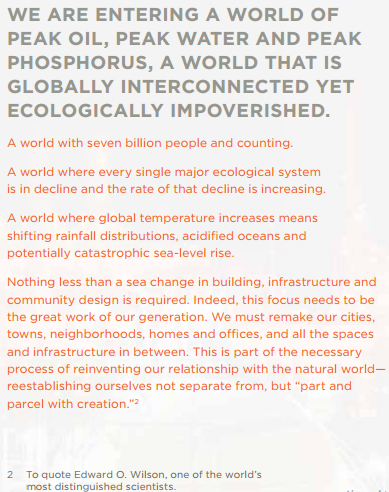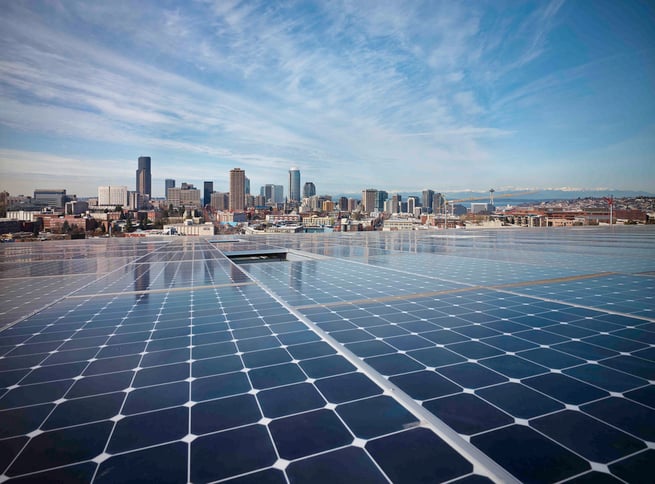Advances in sustainability are revolutionizing the construction and building materials industries like never before. However, it's not just the firms and workers of these sectors that are or will be affected — all beings can experience an improved standard of living with healthier materials in place and a diminished use of natural resources.
When building materials managers and construction leaders act as ambassadors for the sustainable building movement, they not only decrease the world’s carbon footprint but also tap into a highly profitable market. Influencing clients won’t be so difficult once they see – as many others have – that various sources have proven consumers are willing to pay more in the short term for the long-term payoff of an energy-efficient building. Disclosing energy-efficient renovations when listing houses, condos, and townhomes on the market is resulting in more units sold at higher prices as well as less time listed, according to new real estate studies.
While amazing feats have already been made in the construction industry, the Living Building Challenge (LBC) certification created and overseen by the International Living Future Institute (ILFI) is holding building owners to a new standard. It has been cited as, "the most advanced measure of sustainability for buildings and landscapes possible today" by Seattle Department of Construction & Inspections' Director, Nathan Torgelson.

Leadership in Energy and Environmental Design (LEED)
The LEED standard of the U.S. Green Building Council (USGBC) is the most widely used green building rating system in the world.
With over 150 countries participating, LEED reports that there are currently 13.8 billion square feet of certified construction space with 1.85 million square feet being added daily. The popularity of the movement is growing exponentially — 88 of the Fortune 100 companies currently build green and USGBC estimates that nearly 5 million people experience a LEED building every day.
The results of building green are impressive. According to LEED, "[their] projects are responsible for diverting over 80 million tons of waste from landfills. Compared to the average commercial building, LEED Gold buildings in the General Services Administration’s portfolio consume a quarter less energy and generate 34% lower greenhouse gas emissions."
The green standards of LEED and LBC are establishing building grounds that will elevate the world into a more sustainable future.
The Living Building Challenge (LBC)
With a belief that is premised on a "vision for the future" and "reconciling humanity's relationship with the natural world," the International Living Future Institute leads more than eight cutting-edge programs that tap into nearly every aspect of society. Building owners wishing to receive the ultimate "Living Certification" must meet the 20 "petal” requirements of seven different categories designated by the International Living Future Institute:
Place 
- Limits to growth
- Urban agriculture
- Habitat exchange
- Car-free living
Water
- Net positive water
Energy
- Net positive energy
Health and Happiness
- Civilized environment
- Healthy interior environment
- Biophilic environment
Materials
- Red list
- Embodied carbon footprint
- Responsible industry
- Living economy sourcing
- Net positive waste
Equity
- Human scale + human places
- Universal access to nature & place
- Equitable investment
- JUST organizations
Beauty
- Beauty + Spirit
- Inspiration + Education
Run primarily by 400 volunteers across nearly 30 countries, the ILFI defines the Living Building Challenge as "the built environment’s most rigorous and ambitious performance standard." They do offer two other certifications that are not quite as rigorous and still command green effort:
- The "Petal Certification" requires the achievement of at least three of the seven petals.
- The "Net Zero Certification" requires four of the imperatives to be achieved and is described as having one hundred percent of the building’s energy needs on a net annual basis supplied by on-site renewable energy - with no combustion allowed.
"To date, twenty-one projects have achieved certification through the LBC, five of which have achieved Full Certification, and many others have entered the twelve-month operational phase required prior to audit," according to the ILFI.
Buildings that Have Taken the Lead

Deemed the greenest commercial building in the world, the Bullitt Center in Seattle, Washington has predicted its lifespan at 250 years. The six-story structure is powered by 575 PV solar panels. All water needs are supplied by the treated water that accumulates from rainwater in a cistern in the basement. Its impressive list of features continues:
The building is a type-IV heavy timber structure, made of Forest Stewardship Council (FSC) certified glulam beams and dimensional lumber. The building sits atop a ground-source heat exchange system made up of 26 wells, each reaching a depth of 400 feet. All materials used in the building were screened for compliance with the Materials Red List to restrict toxic chemicals. The wide variety of performance-based attributes is shared with the public through an ongoing tour program, a public exhibition space, and a number of research projects all managed by the University of Washington’s Integrated Design Lab.
In addition to the impressive list of schools, offices, residences and more that the ILFI lists under Case Studies, two well-known conglomerates are also making green strides. The U.S. Department of Energy featured Hilton Worldwide and Whole Foods Market in their Better Buildings Challenge where the companies swapped energy teams to audit one another and determine how to further refine their green efforts.
Aaron Daly, Whole Foods Market's global energy coordinator states that an energy audit is a baseline measurement because "you can't change what you don't measure."
As stewards of the environment, Hilton has declared that they are ISO 50,001 certified and appear to take their energy management plan seriously. Their efforts have reportedly saved them $550 million through energy, water, and waste efficiency.
Energy efficiency is one of the best ways to reduce energy waste and lower our carbon footprint.
The U.S. Department of Energy states that lighting represents the largest source of electricity consumption in U.S. commercial buildings at an estimated cost of $38 billion a year. "With buildings accounting for 40 percent of America’s energy use, constructing more efficient workspaces is helping to reduce the country’s carbon emissions."
What Construction and Building Materials Leaders Can Do
Become LEED certified. "LEED professional credentials are at the heart of the green building movement," states LEED's website. More than 235,000 individuals have earned their LEED Green Associate, LEED AP or LEED Fellow credentials. Learn more.
- LEED AP: Affirms advanced knowledge in green building and expertise in a particular LEED rating system. The LEED AP is available with a variety of specialties for professionals to demonstrate proficiency in certain building types.
- LEED Green Associate: Demonstrates a solid and current foundation in green building principles and practices.
- LEED Fellow: A peer-nominated designation awarded to highly accomplished individuals with ten or more years of professional green building experience.
Learn, educate and influence. This is not to assume that building experts are not aware of sustainable practices, but as these programs have shown, there is always room for improvement. The more ambassadors for environmental protection the world can have in key industries, the better.
From the inception of building materials being made to the actual construction process, all those involved can have a significant impact on the world. Professionals in the industry serve as conduits of information and when consumers come seeking advice for construction or renovations – being able to show clients that energy efficient models are proven to be both good for the Earth and their finances will ultimately leave everyone satisfied.


